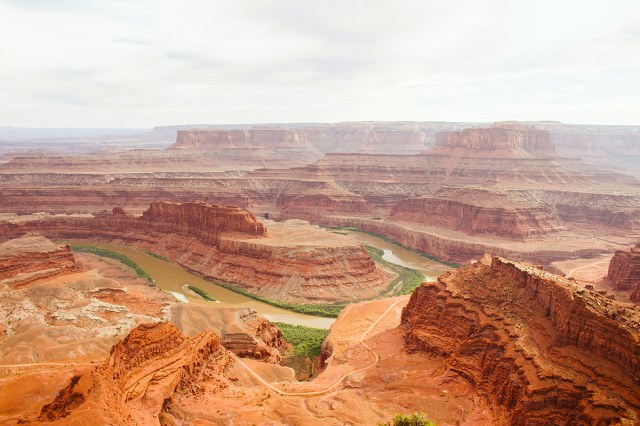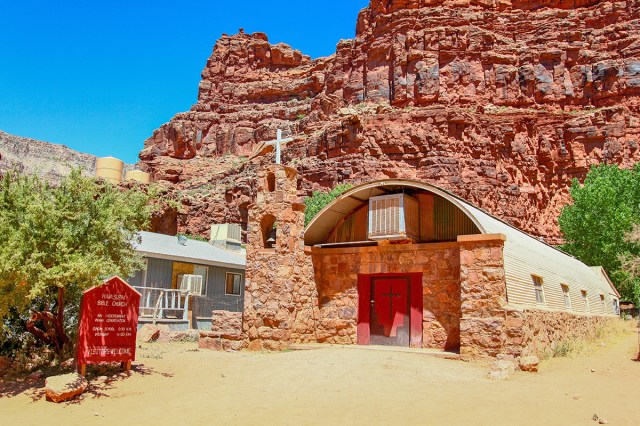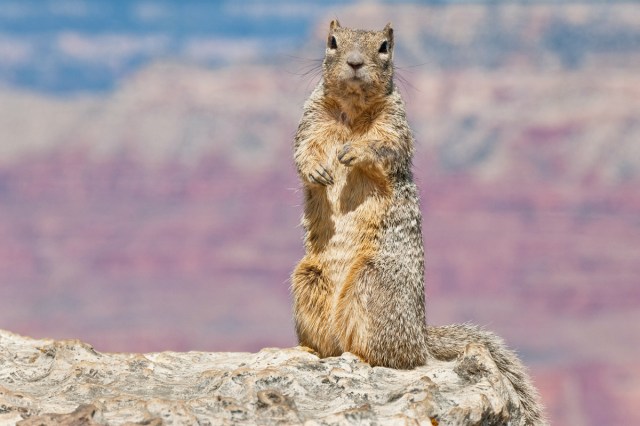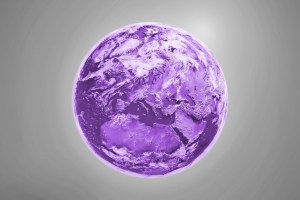
Grand Canyon National Park Is Bigger Than Rhode Island
The Grand Canyon and its surrounding area were officially designated as a national park on February 26, 1919. In 1975, President Gerald Ford signed the Grand Canyon National Park Enlargement Act, which increased the park’s size from 673,575 acres to roughly 1.2 million acres. This act made the park larger than the tiniest U.S. state, Rhode Island.
All told, Grand Canyon National Park covers 1,904 square miles. The Ocean State, on the other hand, has a total land area of just 1,033.9 square miles, plus an added 511.1 square miles of water within its borders. That makes the park about 23% larger than Rhode Island’s land and water area combined. Grand Canyon National Park is also bigger than dozens of countries, including Samoa, Luxembourg, Cabo Verde, and many more.

There’s a Town Located Inside the Grand Canyon
Havasu Canyon is a southward branching canyon formed by the Havasu Creek tributary of the Colorado River. It’s located in the western part of the Grand Canyon, though it technically falls outside the boundaries of Grand Canyon National Park. The area is managed by the Havasupai Tribe, hundreds of whom live in the small town of Supai, Arizona, located within Havasu Canyon. The town has 47 housing units and 214 full-time residents, according to the 2020 Census.
This remote town sits about 3,000 feet below the Grand Canyon’s rim and is located 8 miles from the nearest road. In order to reach Supai, visitors must either fly in by helicopter, hike the length of the trail, or ride a mule into town. Speaking of mules, Supai is the last town in the United States where daily mail is officially delivered by a mule train — which the U.S. Postal Service has provided for the residents of Supai since the 1930s.

The Canyon Continually Changes Shape
The Colorado River that flows through the Grand Canyon is partially responsible for the canyon’s shape. Over the course of the last 5 to 6 million years, the river has eroded the rocks that once filled the space, thus widening and deepening the canyon.
This is a geological process called downcutting, in which hydraulic action from a running water source can have drastic effects on the overall physical landscape. And this process didn’t just occur back in prehistoric times: The Grand Canyon continues to change shape — albeit very slowly — right before our eyes.
According to the United States Geological Survey, “The canyon isn’t fully formed as long as there is water flowing,” because the gushing waters continue to cause erosion. The National Park Service also points out that the Grand Canyon “isn’t getting deeper nearly as fast as it is getting wider.” So while we’re not likely to see the Grand Canyon drastically change shape in our lifetimes, it’ll continue to slowly shift over time.
More Interesting Reads

There Are Hundreds of Unexplored Caves in the Canyon
There are an estimated 1,000 caves located throughout the Grand Canyon, though only 335 of these caverns have been recorded thus far. Today, the caves serve as an important refuge for several wildlife species, including some of the 22 different bat species that live in the canyon. These caves also contain fossils of extinct animals and prehistoric human-made artifacts, thus providing researchers with a fascinating glimpse into the past.
Modern scientists began exploring the caves within the canyon in the 1930s. In 1933, researchers came upon tiny split-twig animal effigies in the caves, which are believed to date to around 4,095 years ago. In 1936, archaeologist Mark Raymond Harrington and geologist Edward Schenk descended into Rampart Cave, discovering a vast smattering of fossilized dung produced by the now-extinct Shasta ground sloth. Currently, these caves are closed to the public, but they remain open for scientific research.

The Hopi Tribe Sees the Grand Canyon as a Gateway to the Underworld
The Hopi are an Indigenous tribe that have resided primarily in modern-day Arizona for more than 2,000 years. The Grand Canyon has long played a pivotal role in Hopi mythology, as members of the Hopi Tribe believe it to be what they call a sipapu. This roughly translates to “place of emergence,” as it’s believed to be a gateway to the underworld.
The Hopi say the sipapu is located at the confluence of the Colorado and Little Colorado rivers. According to the mythology, it’s where their ancestors emerged from the underworld into the realm we live in today. The Hopi also believe the sipapu is a place where the dead can reemerge from the afterlife.

Rock Squirrels Cause the Most Injuries to Visitors
Though rattlesnakes and gila monsters contain venom, they typically avoid humans, so the odds of you being attacked by one in the Grand Canyon are quite slim. Rock squirrels, on the other hand, pose a far greater risk to parkgoers — at least with regard to the total frequency of incidents. In 2021, the National Park Service warned, “Although they may appear harmless and even curious about you, those little rock squirrels cause the most injuries to visitors.”
Unfortunately, previous parkgoers have made the mistake of feeding the squirrels, so these little critters may come up to you in search of food. But be careful: They bite. A rock squirrel can easily pierce through the skin of your finger and draw blood, which may require medical attention. On busier weekends, as many as 30 tourists may be sent for treatment on their injured fingers. The National Park Service advises guests to keep at least 50 feet away from rock squirrels and other small wildlife.

The Photographs of Two Brothers Helped Popularize the Grand Canyon
Ellsworth Kolb arrived at the Grand Canyon in 1901, with his brother Emery joining the following year. While Emery was waiting for a train to the canyon in the nearby town of Williams, Arizona, he noticed a local photography business for sale. Emery bought the business for $425 (about $16,000 today) before going off to meet Ellsworth. In the years that followed, the pair established a thriving business taking photographs of tourists, and those photos helped popularize the Grand Canyon nationwide.
The Kolb brothers set up a small shack near the Bright Angel Trail, where they took photos of tourists riding mules down into the canyon. By the time those folks came back, the Kolbs had their printed photos ready for sale, which were often snatched up by the delighted tourists. A New York Times obituary for Emery Kolb estimates he photographed more than 1.5 million tourists during his time at the Grand Canyon.
In 1905, the brothers constructed the now-famous Kolb Studio, which operated for 75 years and remains a historic park landmark. They also spent 12 years capturing photos and videos of the canyon before touring the country to show Americans the landmark in all its splendor. Their work helped paint the Grand Canyon as a must-see tourist destination.












